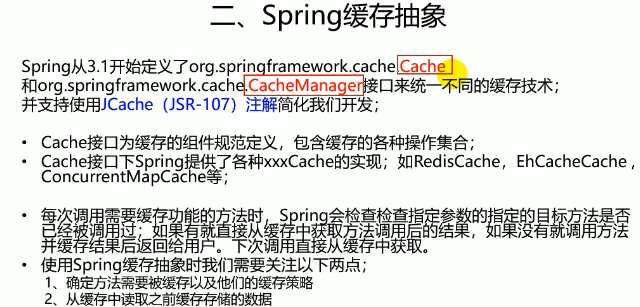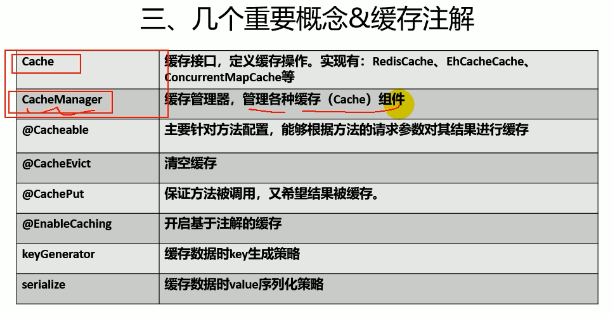一.缓存


缓存配置:
package com.atguigu.cache.config; import org.springframework.cache.interceptor.KeyGenerator; import org.springframework.context.annotation.Bean; import org.springframework.context.annotation.Configuration; import java.lang.reflect.Method; import java.util.Arrays; @Configuration public class MyCacheConfig { //配置key @Bean("myKeyGenerator") public KeyGenerator keyGenerator(){ return new KeyGenerator(){ @Override public Object generate(Object target, Method method, Object... params) { return method.getName()+"["+ Arrays.asList(params).toString()+"]"; } }; } }
缓存使用及原理
package com.atguigu.cache.service; import com.atguigu.cache.bean.Employee; import com.atguigu.cache.mapper.EmployeeMapper; import org.springframework.beans.factory.annotation.Autowired; import org.springframework.cache.annotation.*; import org.springframework.stereotype.Service; @CacheConfig(cacheNames="emp"/*,cacheManager = "employeeCacheManager"*/) //抽取缓存的公共配置 @Service public class EmployeeService { @Autowired EmployeeMapper employeeMapper; /** * 将方法的运行结果进行缓存;以后再要相同的数据,直接从缓存中获取,不用调用方法; * CacheManager管理多个Cache组件的,对缓存的真正CRUD操作在Cache组件中,每一个缓存组件有自己唯一一个名字; * * * 原理: * 1、自动配置类;CacheAutoConfiguration * 2、缓存的配置类 * org.springframework.boot.autoconfigure.cache.GenericCacheConfiguration * org.springframework.boot.autoconfigure.cache.JCacheCacheConfiguration * org.springframework.boot.autoconfigure.cache.EhCacheCacheConfiguration * org.springframework.boot.autoconfigure.cache.HazelcastCacheConfiguration * org.springframework.boot.autoconfigure.cache.InfinispanCacheConfiguration * org.springframework.boot.autoconfigure.cache.CouchbaseCacheConfiguration * org.springframework.boot.autoconfigure.cache.RedisCacheConfiguration * org.springframework.boot.autoconfigure.cache.CaffeineCacheConfiguration * org.springframework.boot.autoconfigure.cache.GuavaCacheConfiguration * org.springframework.boot.autoconfigure.cache.SimpleCacheConfiguration【默认】 * org.springframework.boot.autoconfigure.cache.NoOpCacheConfiguration * 3、哪个配置类默认生效:SimpleCacheConfiguration; * * 4、给容器中注册了一个CacheManager:ConcurrentMapCacheManager * 5、可以获取和创建ConcurrentMapCache类型的缓存组件;他的作用将数据保存在ConcurrentMap中; * * 运行流程: * @Cacheable: * 1、方法运行之前,先去查询Cache(缓存组件),按照cacheNames指定的名字获取; * (CacheManager先获取相应的缓存),第一次获取缓存如果没有Cache组件会自动创建。 * 2、去Cache中查找缓存的内容,使用一个key,默认就是方法的参数; * key是按照某种策略生成的;默认是使用keyGenerator生成的,默认使用SimpleKeyGenerator生成key; * SimpleKeyGenerator生成key的默认策略; * 如果没有参数;key=new SimpleKey(); * 如果有一个参数:key=参数的值 * 如果有多个参数:key=new SimpleKey(params); * 3、没有查到缓存就调用目标方法; * 4、将目标方法返回的结果,放进缓存中 * * @Cacheable标注的方法执行之前先来检查缓存中有没有这个数据,默认按照参数的值作为key去查询缓存, * 如果没有就运行方法并将结果放入缓存;以后再来调用就可以直接使用缓存中的数据; * * 核心: * 1)、使用CacheManager【ConcurrentMapCacheManager】按照名字得到Cache【ConcurrentMapCache】组件 * 2)、key使用keyGenerator生成的,默认是SimpleKeyGenerator * * * 几个属性: * cacheNames/value:指定缓存组件的名字;将方法的返回结果放在哪个缓存中,是数组的方式,可以指定多个缓存; * * key:缓存数据使用的key;可以用它来指定。默认是使用方法参数的值 1-方法的返回值 * 编写SpEL; #i d;参数id的值 #a0 #p0 #root.args[0] * getEmp[2] * * keyGenerator:key的生成器;可以自己指定key的生成器的组件id * key/keyGenerator:二选一使用; * * * cacheManager:指定缓存管理器;或者cacheResolver指定获取解析器 * * condition:指定符合条件的情况下才缓存; * ,condition = "#id>0" * condition = "#a0>1":第一个参数的值》1的时候才进行缓存 * * unless:否定缓存;当unless指定的条件为true,方法的返回值就不会被缓存;可以获取到结果进行判断 * unless = "#result == null" * unless = "#a0==2":如果第一个参数的值是2,结果不缓存; * sync:是否使用异步模式 * @param id * @return * */ @Cacheable(value = {"emp"}/*,keyGenerator = "myKeyGenerator",condition = "#a0>1",unless = "#a0==2"*/) public Employee getEmp(Integer id){ System.out.println("查询"+id+"号员工"); Employee emp = employeeMapper.getEmpById(id); return emp; } /** * @CachePut:既调用方法,又更新缓存数据;同步更新缓存 * 修改了数据库的某个数据,同时更新缓存; * 运行时机: * 1、先调用目标方法 * 2、将目标方法的结果缓存起来 * * 测试步骤: * 1、查询1号员工;查到的结果会放在缓存中; * key:1 value:lastName:张三 * 2、以后查询还是之前的结果 * 3、更新1号员工;【lastName:zhangsan;gender:0】 * 将方法的返回值也放进缓存了; * key:传入的employee对象 值:返回的employee对象; * 4、查询1号员工? * 应该是更新后的员工; * key = "#employee.id":使用传入的参数的员工id; * key = "#result.id":使用返回后的id * @Cacheable的key是不能用#result * 为什么是没更新前的?【1号员工没有在缓存中更新】 * */ @CachePut(/*value = "emp",*/key = "#result.id") public Employee updateEmp(Employee employee){ System.out.println("updateEmp:"+employee); employeeMapper.updateEmp(employee); return employee; } /** * @CacheEvict:缓存清除 * key:指定要清除的数据 * allEntries = true:指定清除这个缓存中所有的数据 * beforeInvocation = false:缓存的清除是否在方法之前执行 * 默认代表缓存清除操作是在方法执行之后执行;如果出现异常缓存就不会清除 * * beforeInvocation = true: * 代表清除缓存操作是在方法运行之前执行,无论方法是否出现异常,缓存都清除 * * */ @CacheEvict(value="emp",beforeInvocation = true/*key = "#id",*/) public void deleteEmp(Integer id){ System.out.println("deleteEmp:"+id); //employeeMapper.deleteEmpById(id); int i = 10/0; } // @Caching 定义复杂的缓存规则 @Caching( cacheable = { @Cacheable(/*value="emp",*/key = "#lastName") }, put = { @CachePut(/*value="emp",*/key = "#result.id"), @CachePut(/*value="emp",*/key = "#result.email") } ) public Employee getEmpByLastName(String lastName){ return employeeMapper.getEmpByLastName(lastName); } }
使用redis
1.配置redis自定义config
package com.atguigu.cache.config; import com.atguigu.cache.bean.Department; import com.atguigu.cache.bean.Employee; import org.springframework.context.annotation.Bean; import org.springframework.context.annotation.Configuration; import org.springframework.context.annotation.Primary; import org.springframework.data.redis.cache.RedisCacheManager; import org.springframework.data.redis.connection.RedisConnectionFactory; import org.springframework.data.redis.core.RedisTemplate; import org.springframework.data.redis.serializer.Jackson2JsonRedisSerializer; import java.net.UnknownHostException; @Configuration public class MyRedisConfig { @Bean public RedisTemplate<Object, Employee> empRedisTemplate( RedisConnectionFactory redisConnectionFactory) throws UnknownHostException { RedisTemplate<Object, Employee> template = new RedisTemplate<Object, Employee>(); template.setConnectionFactory(redisConnectionFactory); Jackson2JsonRedisSerializer<Employee> ser = new Jackson2JsonRedisSerializer<Employee>(Employee.class); template.setDefaultSerializer(ser); return template; } @Bean public RedisTemplate<Object, Department> deptRedisTemplate( RedisConnectionFactory redisConnectionFactory) throws UnknownHostException { RedisTemplate<Object, Department> template = new RedisTemplate<Object, Department>(); template.setConnectionFactory(redisConnectionFactory); Jackson2JsonRedisSerializer<Department> ser = new Jackson2JsonRedisSerializer<Department>(Department.class); template.setDefaultSerializer(ser); return template; } //CacheManagerCustomizers可以来定制缓存的一些规则 @Primary //将某个缓存管理器作为默认的 @Bean public RedisCacheManager employeeCacheManager(RedisTemplate<Object, Employee> empRedisTemplate){ RedisCacheManager cacheManager = new RedisCacheManager(empRedisTemplate); //key多了一个前缀 //使用前缀,默认会将CacheName作为key的前缀 cacheManager.setUsePrefix(true); return cacheManager; } @Bean public RedisCacheManager deptCacheManager(RedisTemplate<Object, Department> deptRedisTemplate){ RedisCacheManager cacheManager = new RedisCacheManager(deptRedisTemplate); //key多了一个前缀 //使用前缀,默认会将CacheName作为key的前缀 cacheManager.setUsePrefix(true); return cacheManager; } }
2.使用redis
package com.atguigu.cache.service; import com.atguigu.cache.bean.Department; import com.atguigu.cache.mapper.DepartmentMapper; import org.springframework.beans.factory.annotation.Autowired; import org.springframework.beans.factory.annotation.Qualifier; import org.springframework.cache.Cache; import org.springframework.cache.annotation.CacheConfig; import org.springframework.cache.annotation.Cacheable; import org.springframework.data.redis.cache.RedisCacheManager; import org.springframework.stereotype.Service; @Service public class DeptService { @Autowired DepartmentMapper departmentMapper; @Qualifier("deptCacheManager") @Autowired RedisCacheManager deptCacheManager; /** * 缓存的数据能存入redis; * 第二次从缓存中查询就不能反序列化回来; * 存的是dept的json数据;CacheManager默认使用RedisTemplate<Object, Employee>操作Redis * * * @param id * @return */ //方式一: // @Cacheable(cacheNames = "dept",cacheManager = "deptCacheManager") // public Department getDeptById(Integer id){ // System.out.println("查询部门"+id); // Department department = departmentMapper.getDeptById(id); // return department; // } //方式二: // 使用缓存管理器得到缓存,进行api调用 public Department getDeptById(Integer id){ System.out.println("查询部门"+id); Department department = departmentMapper.getDeptById(id); //获取某个缓存 Cache dept = deptCacheManager.getCache("dept"); dept.put("dept:1",department); return department; } }
3.测试类
package com.atguigu.cache; import com.atguigu.cache.bean.Employee; import com.atguigu.cache.mapper.EmployeeMapper; import org.junit.Test; import org.junit.runner.RunWith; import org.springframework.beans.factory.annotation.Autowired; import org.springframework.boot.test.context.SpringBootTest; import org.springframework.data.redis.core.RedisTemplate; import org.springframework.data.redis.core.StringRedisTemplate; import org.springframework.test.context.junit4.SpringRunner; @RunWith(SpringRunner.class) @SpringBootTest public class Springboot01CacheApplicationTests { @Autowired EmployeeMapper employeeMapper; @Autowired StringRedisTemplate stringRedisTemplate; //操作k-v都是字符串的 @Autowired RedisTemplate redisTemplate; //k-v都是对象的 @Autowired RedisTemplate<Object, Employee> empRedisTemplate; /** * Redis常见的五大数据类型 * String(字符串)、List(列表)、Set(集合)、Hash(散列)、ZSet(有序集合) * stringRedisTemplate.opsForValue()[String(字符串)] * stringRedisTemplate.opsForList()[List(列表)] * stringRedisTemplate.opsForSet()[Set(集合)] * stringRedisTemplate.opsForHash()[Hash(散列)] * stringRedisTemplate.opsForZSet()[ZSet(有序集合)] */ @Test public void test01(){ //给redis中保存数据 //stringRedisTemplate.opsForValue().append("msg","hello"); // String msg = stringRedisTemplate.opsForValue().get("msg"); // System.out.println(msg); // stringRedisTemplate.opsForList().leftPush("mylist","1"); // stringRedisTemplate.opsForList().leftPush("mylist","2"); } //测试保存对象 @Test public void test02(){ Employee empById = employeeMapper.getEmpById(1); //默认如果保存对象,使用jdk序列化机制,序列化后的数据保存到redis中 //redisTemplate.opsForValue().set("emp-01",empById); //1、将数据以json的方式保存 //(1)自己将对象转为json //(2)redisTemplate默认的序列化规则;改变默认的序列化规则; empRedisTemplate.opsForValue().set("emp-01",empById); } @Test public void contextLoads() { Employee empById = employeeMapper.getEmpById(1); System.out.println(empById); } }